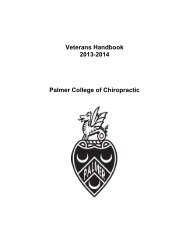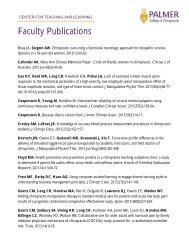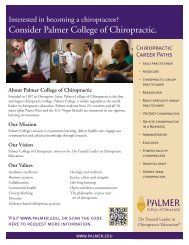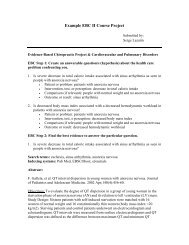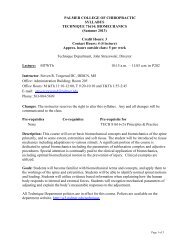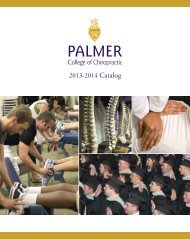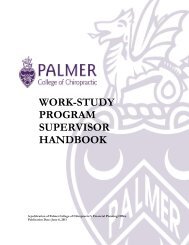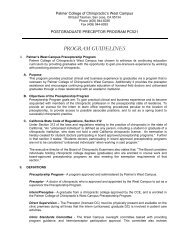ma1-091031-insightfal-bmf:Layout 1 - Palmer College of Chiropractic
ma1-091031-insightfal-bmf:Layout 1 - Palmer College of Chiropractic
ma1-091031-insightfal-bmf:Layout 1 - Palmer College of Chiropractic
Create successful ePaper yourself
Turn your PDF publications into a flip-book with our unique Google optimized e-Paper software.
I was interviewed<br />
not too long ago<br />
by the editor <strong>of</strong><br />
the Beacon, the<br />
student newspaper<br />
on <strong>Palmer</strong> <strong>College</strong>’s Davenport Campus. The last thing he<br />
asked me was, “How do you bridge the gap between chiropractic<br />
philosophy and science?” In many ways, I thought this<br />
was the most important question <strong>of</strong> the interview. Though<br />
it was the first time I had been asked directly to address this<br />
issue, I realized there have been many times in the three years<br />
since I joined <strong>Palmer</strong> that this question has been hovering in<br />
the room.<br />
The Merriam-Webster definition <strong>of</strong> philosophy that I feel<br />
comes closest to what we mean by chiropractic philosophy is<br />
“the most basic beliefs, concepts, and attitudes <strong>of</strong> an individual<br />
or group.” On the other hand, science is defined as “knowledge<br />
or a system <strong>of</strong> knowledge covering general truths or a system or<br />
method reconciling practical ends with scientific laws.”<br />
When I read these definitions, I don’t see a gap between<br />
philosophy and science. In fact, philosophy forms the very<br />
foundation <strong>of</strong> our translational scientific program at the <strong>Palmer</strong><br />
Center for <strong>Chiropractic</strong> Research—and we’re addressing more<br />
than low back pain. Let me give you some examples ...<br />
Currently, we’re conducting studies to determine if chiropractic<br />
care is effective in treating conditions such as tempormandibular<br />
disorder, neck pain and hypertension. Hypertension research<br />
is especially important because the condition impacts 50 million<br />
U.S. adults, less than a quarter <strong>of</strong> whom are able to achieve<br />
normal blood pressure levels. If chiropractic is shown to be<br />
an effective treatment for hypertension, people living with this<br />
spinal column<br />
Bridging the gap between<br />
chiropractic philosophy<br />
and science<br />
Vice Chancellor for Research and Health Policy<br />
Christine Goertz, D.C., Ph.D.<br />
disease will have an option beyond medications with side effects<br />
and difficult-to-adhere-to lifestyle modifications.<br />
In another study, we’re collecting data in the <strong>Palmer</strong> Clinics to<br />
measure outcomes in real-practice situations. In this setting,<br />
we can better explore the results you might obtain in your<br />
own <strong>of</strong>fice. This type <strong>of</strong> study is a great example <strong>of</strong> how the<br />
“translational research” we’re pursuing easily translates into<br />
information that chiropractors throughout the world can relate<br />
to, and most importantly, use.<br />
Something you might not expect a chiropractic research center<br />
to be doing is looking at chiropractic utilization and costs,<br />
using a large government-sponsored data set. Yet having this<br />
information can help us compare the costs <strong>of</strong> chiropractic care<br />
to medical and other healthcare pr<strong>of</strong>essions.<br />
To learn more about how chiropractic adjustments impact the<br />
nervous system, and how the subluxation impacts local tissues<br />
and overall behavior, we’re doing experiments with animal<br />
models. Research on cadavers is being undertaken, too, so<br />
that we can learn more about how adjustments impact biomechanics<br />
in the low back and neck.<br />
These areas <strong>of</strong> inquiry can appear quite diverse initially but<br />
there is a common thread that runs through them. Quite simply,<br />
every scientific study we conduct is designed to answer a<br />
few fundamental questions: Can we demonstrate our most<br />
basic beliefs on how chiropractic works? Can we show that our<br />
treatment concepts are effective? Are there things we can learn<br />
that will help us take better care <strong>of</strong> patients?<br />
In the end, every study is an attempt to reconcile our most<br />
basic beliefs with scientific laws. l<br />
21




